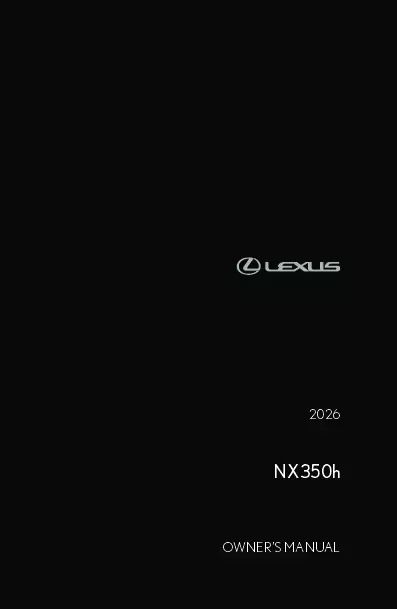2026 Lexus NX 350h Owner's Manual

Table of Contents
2026 Lexus NX 350h Overview
Owner's Manual
The Owner's Manual for the 2026 Lexus NX 350h serves as an essential guidebook that every owner should familiarize themselves with. This comprehensive document provides detailed information about the vehicle's features, capabilities, and operating procedures. It includes maintenance tips, warranty information, and important safety guidelines, ensuring that drivers can make the most out of their driving experience while keeping their vehicle in optimal condition. Understanding the owner's manual empowers you to utilize the NX 350h's advanced technologies and systems effectively, promoting better ownership experiences and vehicle longevity.
Introduction
The 2026 Lexus NX 350h is a remarkable entry into the compact luxury hybrid SUV market, blending sophistication with eco-friendliness. This model stands out with its striking design, refined performance, and an array of cutting-edge technology features. Designed to cater to modern drivers, the NX 350h not only prioritizes comfort and luxury but also focuses on sustainable driving with its hybrid powertrain, making it an ideal choice for those seeking efficiency without sacrificing style.
Powertrains
At the heart of the 2026 NX 350h is a powerful yet efficient hybrid powertrain that combines a gasoline engine with an electric motor. This innovative setup delivers a seamless balance of power, providing impressive acceleration while maintaining exceptional fuel efficiency. It's engineered to automatically switch between electric and gasoline power, ensuring that drivers can optimize their drives based on varying conditions. The advanced all-wheel-drive system further enhances traction, making it versatile for all weather and terrain specifications.
Trims
The Lexus NX 350h offers a variety of trims designed to cater to different preferences and needs, including the base model, Luxury, and F Sport trims. Each trim comes with unique styling and feature upgrades, allowing customers to select the best fit for their lifestyle. The Luxury trim emphasizes comfort with added premium materials and enhanced audio systems, while the F Sport trim adds a dynamic flair with sport-tuned suspension and sporty design elements.
Features
The 2026 NX 350h is loaded with an impressive array of features that enhance both comfort and safety. Key highlights include a large touchscreen infotainment system with intuitive navigation, smartphone integration through Apple CarPlay and Android Auto, and a panoramic sunroof for a more open feel. Safety features are paramount, with the latest Lexus Safety System+ technology, including adaptive cruise control, lane-keeping assist, and a pre-collision system, ensuring peace of mind on every journey.
User manual download
The Lexus NX 350h owner manual for the 2026 model year is to be found in PDF downloadable format on this page. The owner manual for the model year 2026 is free and in English, but the repair manuals are usually not easy to get and may cost more.
Manual Questions
Fill the form below and someone will help you!
